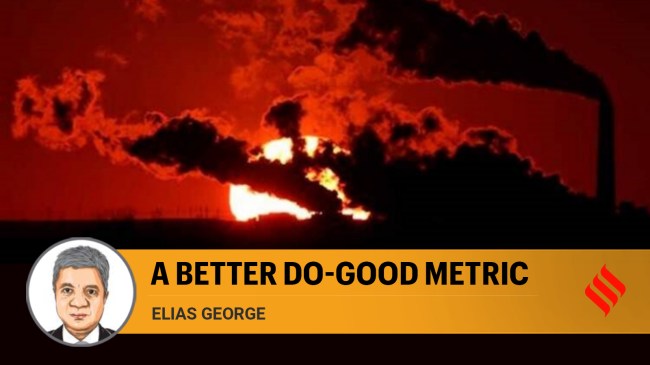Opinion It’s time to rethink the environmental, social and governance criteria
The most worrying critique of ESG is that by promoting it as a pious talisman, companies and governments may be avoiding hard decisions necessary to confront and overcome climate change, rising inequality
 In light of these concerns, there has been a recent convergence of thinking around the need for organisations to concentrate on the primary aspect that is crucial for our survival: Emissions reduction and reducing environmental impact, while hiving off other unrelated concerns falling within the S and G rubrics and considering them separately.
In light of these concerns, there has been a recent convergence of thinking around the need for organisations to concentrate on the primary aspect that is crucial for our survival: Emissions reduction and reducing environmental impact, while hiving off other unrelated concerns falling within the S and G rubrics and considering them separately. The acronym ESG (Environmental Social Governance) is one of the defining mantras of our times. It pertains to the interconnected worlds of business, government, and civil society. The way companies and other organisations deal with the challenges of E, S, and G — managing the environmental and social impact, as well as how they handle their governance issues — can now be bundled into integrated ESG metrics and ranked by rating agencies. These assessments have become vital for firms to secure their future by de-risking themselves from external uncertainties, as well as to conform to regulatory requirements. ESG ratings are also becoming necessary to attract discerning investments that are driven by two differing considerations: Ring-fencing the financial prospects of companies from adverse environmental and social impacts, and ensuring on behalf of conscientious investors that their funds flow only to companies that enhance the sum of planetary well-being. Companies are racing to burnish their ESG credentials, particularly those in environmentally depredatory sectors like energy and mining.
This blended concept of ESG is now around two decades old, having been launched in an UN-led report of 2005, titled ‘Who Cares Wins: Connecting Financial Markets to a Changing World’, which enjoined financial institutions, investors, and regulators to work together for promoting sustainable environmental, social, and good governance practices in companies. Today, the ESG approach is embedded in the heart of the global corporate landscape, with ESG-infused sustainable investments amounting to more than a third of all invested assets worldwide as per the Global Sustainable Investment Review, 2022.
Measuring ESG credentials is now a thriving global industry, with the many reporting frameworks using a bewildering array of metrics to measure and rank companies. The absence of uniformity and the element of subjectivity in ESG evaluation criteria detract from its credibility, with ESG ratings by different agencies tallying with each other only about half the time as per reports. The prospect of having well-defined and standardised evaluation metrics seems a long way off, on account of the sheer variety of factors involved.
Two decades after its inception, is it time to take a second look at how this ESG edifice has been constructed? Is ESG a piece of unthinkingly received wisdom that now needs to be overhauled? These questions have become central now, given the worrying concerns around its various deficiencies. The world’s biggest asset management firm, BlackRock has abandoned the ESG acronym, taking the view that “ESG is unquestionably in a death spiral” as per a report.
One of the fundamental problems with the ESG approach is what has been described as its element of inherent hypocrisy, with most ESG ratings measuring only the risks that phenomena like climate change and social upheaval pose to an organisation’s performance, rather than the other way around — an approach that is termed as “single materiality”. A company cannot claim to be promoting universal welfare and well-being when its prime focus is on de-risking its financial performance and its assets from external shocks — all under the feel-good mantle of ESG. In the last five years, there has been a move by European regulators to migrate to “double materiality” standards which attempt to also measure the impact that the activities of an organisation can have on the external environmental and social landscape. However, such a layered approach involves overcoming complex challenges, as well as reliance on uncertain assumptions. It is no easy task to capture and measure the external impacts of an organisation in a well-calibrated fashion.
There are also curious consequences arising from bundling the E, S, and G elements together as a combined evaluation and ranking metric. Recently, the ESG Index Provider Dow Jones Indices turfed out the emissions-reducing electric vehicle manufacturer Tesla from the Standard and Poor Sustainability Index, while retaining the oil behemoth Exxon Mobil. Cigarette companies were listed as more ethical investment destinations than Tesla, which was penalised for workplace and governance issues.
The most worrying critique of the ESG game is that by promoting it as a pious talisman, companies, investors, civil society and governments may be avoiding the hard decisions that are necessary to confront and overcome wicked problems like climate change, and rising inequality. Apart from being driven by an organisation’s desire to do good, there is not too much in common between the domain of environmental impact and the social and governance aspects. In light of these concerns, there has been a recent convergence of thinking around the need for organisations to concentrate on the primary aspect that is crucial for our survival: Emissions reduction and reducing environmental impact, while hiving off other unrelated concerns falling within the S and G rubrics and considering them separately. Such a separation will improve comparability, and ensure a clearer focus on the big, burning questions that haunt humanity, like a company’s role in mitigating adverse climate impacts.
In the words of the world’s leading valuation guru, Aswath Damodaran, ESG was “born in sanctimony, nurtured with hypocrisy, and sold with sophistry”. It is time that we went back to the drawing board and unbundled the ESG matrix, reducing its scope and complexity, so that we can measure better, and focus on critical essentials like emission reductions that are now mandatory for our survival.
The writer is retired IAS officer, and partner in a Big4 Consulting Firm






